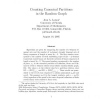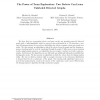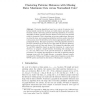126 search results - page 10 / 26 » BAG: a graph theoretic sequence clustering algorithm |
COMBINATORICA
2008
13 years 6 months ago
2008
Algorithms are given for computing the number of n-element diagonal sets and the number of n-element strongly diagonal sets of binary sequences of length at most 2n - 2. The first...
FOCS
1994
IEEE
13 years 11 months ago
1994
IEEE
We show that two cooperating robots can learn exactly any strongly-connected directed graph with n indistinguishable nodes in expected time polynomial in n. We introduce a new typ...
IROS
2008
IEEE
14 years 2 months ago
2008
IEEE
— In many computer vision related applications it is necessary to distinguish between the background of an image and the objects that are contained in it. This is a difficult pr...
DATE
2009
IEEE
14 years 2 months ago
2009
IEEE
—Scheduling task graphs under hard (end-to-end) timing constraints is an extensively studied NP-hard problem of critical importance for predictable software mapping on Multiproce...
DIS
2006
Springer
13 years 11 months ago
2006
Springer
Abstract. Clustering algorithms based on a matrix of pairwise similarities (kernel matrix) for the data are widely known and used, a particularly popular class being spectral clust...



